History of Photography: Kevin Carter and the Ethical Dilemma of Photojournalism
VerifiedAdded on 2023/01/19
|9
|2348
|28
AI Summary
This article delves into the history of photography and explores the work of Kevin Carter, a renowned photojournalist. It discusses the ethical challenges faced by photojournalists and the controversy surrounding Carter's famous photographs. The article also examines the impact of photography on society and the role of photographers in raising awareness about social issues.
Contribute Materials
Your contribution can guide someone’s learning journey. Share your
documents today.
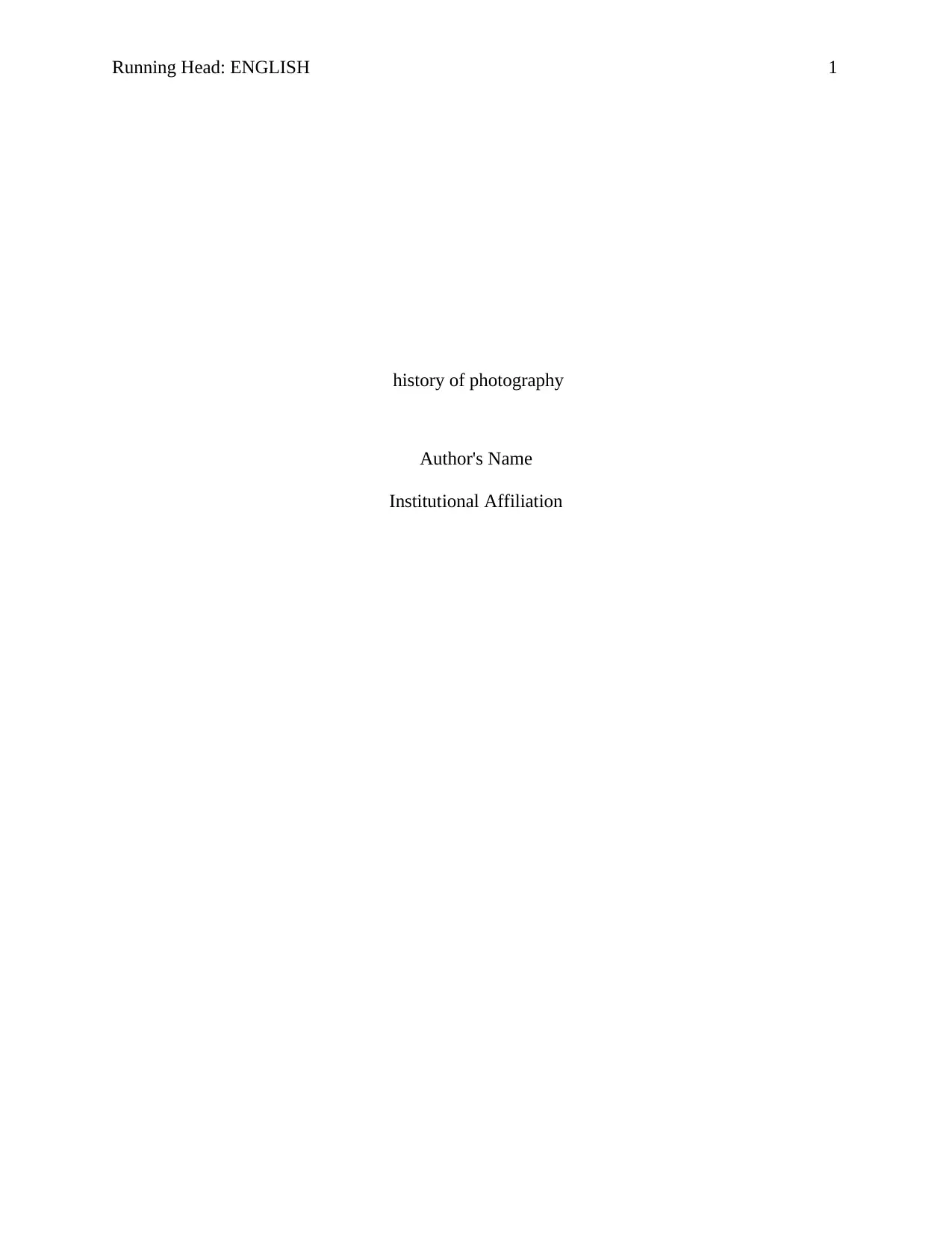
Running Head: ENGLISH 1
history of photography
Author's Name
Institutional Affiliation
history of photography
Author's Name
Institutional Affiliation
Secure Best Marks with AI Grader
Need help grading? Try our AI Grader for instant feedback on your assignments.
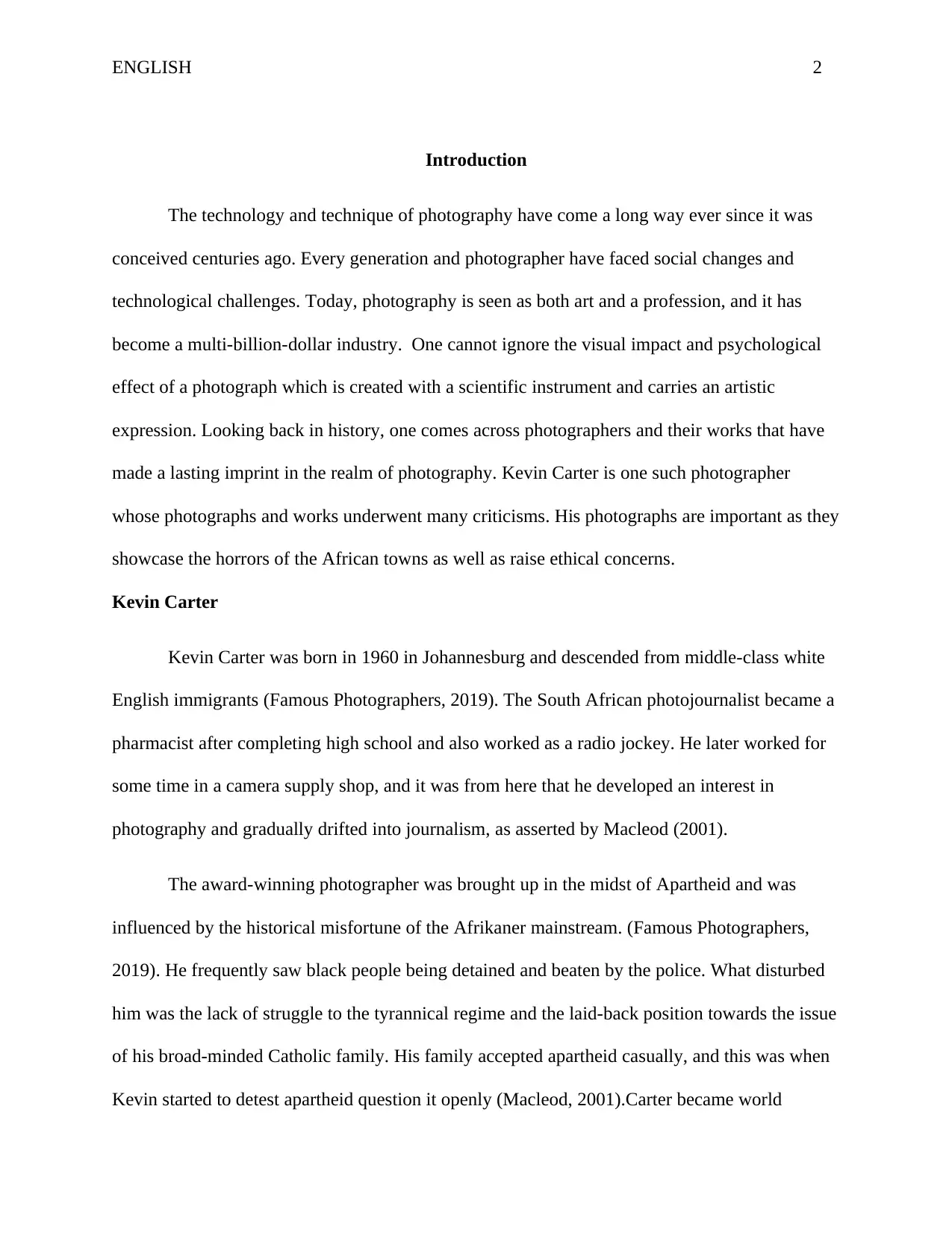
ENGLISH 2
Introduction
The technology and technique of photography have come a long way ever since it was
conceived centuries ago. Every generation and photographer have faced social changes and
technological challenges. Today, photography is seen as both art and a profession, and it has
become a multi-billion-dollar industry. One cannot ignore the visual impact and psychological
effect of a photograph which is created with a scientific instrument and carries an artistic
expression. Looking back in history, one comes across photographers and their works that have
made a lasting imprint in the realm of photography. Kevin Carter is one such photographer
whose photographs and works underwent many criticisms. His photographs are important as they
showcase the horrors of the African towns as well as raise ethical concerns.
Kevin Carter
Kevin Carter was born in 1960 in Johannesburg and descended from middle-class white
English immigrants (Famous Photographers, 2019). The South African photojournalist became a
pharmacist after completing high school and also worked as a radio jockey. He later worked for
some time in a camera supply shop, and it was from here that he developed an interest in
photography and gradually drifted into journalism, as asserted by Macleod (2001).
The award-winning photographer was brought up in the midst of Apartheid and was
influenced by the historical misfortune of the Afrikaner mainstream. (Famous Photographers,
2019). He frequently saw black people being detained and beaten by the police. What disturbed
him was the lack of struggle to the tyrannical regime and the laid-back position towards the issue
of his broad-minded Catholic family. His family accepted apartheid casually, and this was when
Kevin started to detest apartheid question it openly (Macleod, 2001).Carter became world
Introduction
The technology and technique of photography have come a long way ever since it was
conceived centuries ago. Every generation and photographer have faced social changes and
technological challenges. Today, photography is seen as both art and a profession, and it has
become a multi-billion-dollar industry. One cannot ignore the visual impact and psychological
effect of a photograph which is created with a scientific instrument and carries an artistic
expression. Looking back in history, one comes across photographers and their works that have
made a lasting imprint in the realm of photography. Kevin Carter is one such photographer
whose photographs and works underwent many criticisms. His photographs are important as they
showcase the horrors of the African towns as well as raise ethical concerns.
Kevin Carter
Kevin Carter was born in 1960 in Johannesburg and descended from middle-class white
English immigrants (Famous Photographers, 2019). The South African photojournalist became a
pharmacist after completing high school and also worked as a radio jockey. He later worked for
some time in a camera supply shop, and it was from here that he developed an interest in
photography and gradually drifted into journalism, as asserted by Macleod (2001).
The award-winning photographer was brought up in the midst of Apartheid and was
influenced by the historical misfortune of the Afrikaner mainstream. (Famous Photographers,
2019). He frequently saw black people being detained and beaten by the police. What disturbed
him was the lack of struggle to the tyrannical regime and the laid-back position towards the issue
of his broad-minded Catholic family. His family accepted apartheid casually, and this was when
Kevin started to detest apartheid question it openly (Macleod, 2001).Carter became world
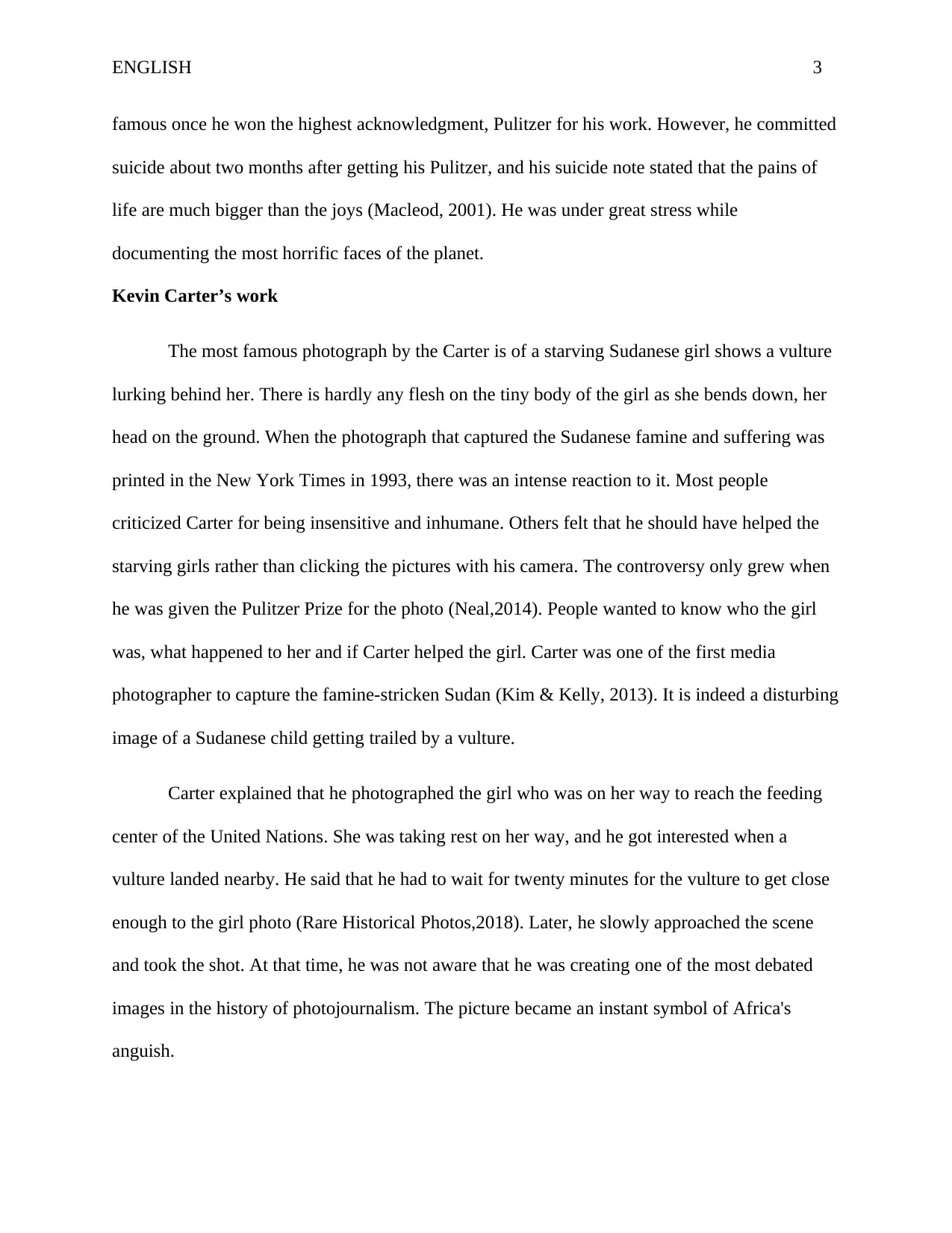
ENGLISH 3
famous once he won the highest acknowledgment, Pulitzer for his work. However, he committed
suicide about two months after getting his Pulitzer, and his suicide note stated that the pains of
life are much bigger than the joys (Macleod, 2001). He was under great stress while
documenting the most horrific faces of the planet.
Kevin Carter’s work
The most famous photograph by the Carter is of a starving Sudanese girl shows a vulture
lurking behind her. There is hardly any flesh on the tiny body of the girl as she bends down, her
head on the ground. When the photograph that captured the Sudanese famine and suffering was
printed in the New York Times in 1993, there was an intense reaction to it. Most people
criticized Carter for being insensitive and inhumane. Others felt that he should have helped the
starving girls rather than clicking the pictures with his camera. The controversy only grew when
he was given the Pulitzer Prize for the photo (Neal,2014). People wanted to know who the girl
was, what happened to her and if Carter helped the girl. Carter was one of the first media
photographer to capture the famine-stricken Sudan (Kim & Kelly, 2013). It is indeed a disturbing
image of a Sudanese child getting trailed by a vulture.
Carter explained that he photographed the girl who was on her way to reach the feeding
center of the United Nations. She was taking rest on her way, and he got interested when a
vulture landed nearby. He said that he had to wait for twenty minutes for the vulture to get close
enough to the girl photo (Rare Historical Photos,2018). Later, he slowly approached the scene
and took the shot. At that time, he was not aware that he was creating one of the most debated
images in the history of photojournalism. The picture became an instant symbol of Africa's
anguish.
famous once he won the highest acknowledgment, Pulitzer for his work. However, he committed
suicide about two months after getting his Pulitzer, and his suicide note stated that the pains of
life are much bigger than the joys (Macleod, 2001). He was under great stress while
documenting the most horrific faces of the planet.
Kevin Carter’s work
The most famous photograph by the Carter is of a starving Sudanese girl shows a vulture
lurking behind her. There is hardly any flesh on the tiny body of the girl as she bends down, her
head on the ground. When the photograph that captured the Sudanese famine and suffering was
printed in the New York Times in 1993, there was an intense reaction to it. Most people
criticized Carter for being insensitive and inhumane. Others felt that he should have helped the
starving girls rather than clicking the pictures with his camera. The controversy only grew when
he was given the Pulitzer Prize for the photo (Neal,2014). People wanted to know who the girl
was, what happened to her and if Carter helped the girl. Carter was one of the first media
photographer to capture the famine-stricken Sudan (Kim & Kelly, 2013). It is indeed a disturbing
image of a Sudanese child getting trailed by a vulture.
Carter explained that he photographed the girl who was on her way to reach the feeding
center of the United Nations. She was taking rest on her way, and he got interested when a
vulture landed nearby. He said that he had to wait for twenty minutes for the vulture to get close
enough to the girl photo (Rare Historical Photos,2018). Later, he slowly approached the scene
and took the shot. At that time, he was not aware that he was creating one of the most debated
images in the history of photojournalism. The picture became an instant symbol of Africa's
anguish.
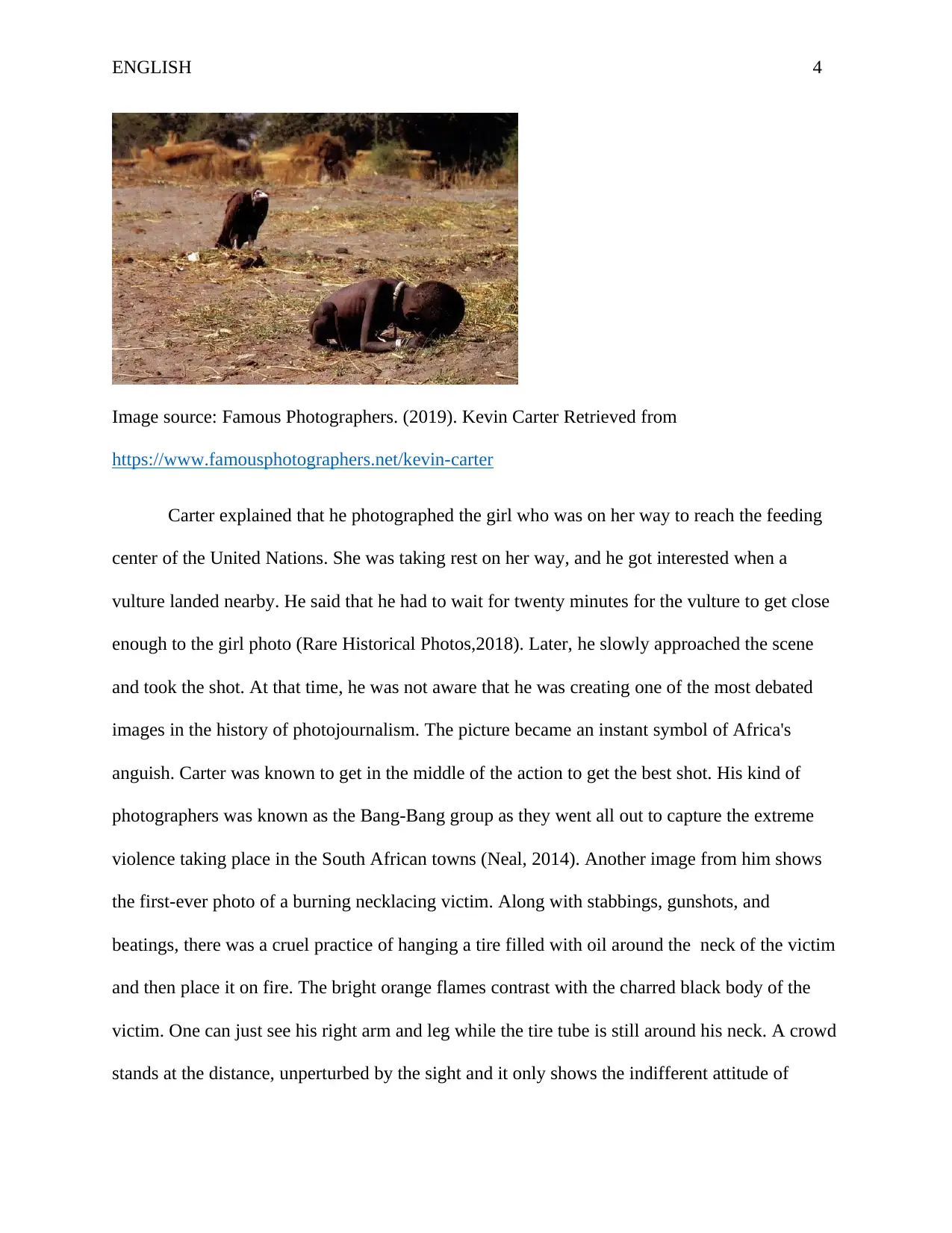
ENGLISH 4
Image source: Famous Photographers. (2019). Kevin Carter Retrieved from
https://www.famousphotographers.net/kevin-carter
Carter explained that he photographed the girl who was on her way to reach the feeding
center of the United Nations. She was taking rest on her way, and he got interested when a
vulture landed nearby. He said that he had to wait for twenty minutes for the vulture to get close
enough to the girl photo (Rare Historical Photos,2018). Later, he slowly approached the scene
and took the shot. At that time, he was not aware that he was creating one of the most debated
images in the history of photojournalism. The picture became an instant symbol of Africa's
anguish. Carter was known to get in the middle of the action to get the best shot. His kind of
photographers was known as the Bang-Bang group as they went all out to capture the extreme
violence taking place in the South African towns (Neal, 2014). Another image from him shows
the first-ever photo of a burning necklacing victim. Along with stabbings, gunshots, and
beatings, there was a cruel practice of hanging a tire filled with oil around the neck of the victim
and then place it on fire. The bright orange flames contrast with the charred black body of the
victim. One can just see his right arm and leg while the tire tube is still around his neck. A crowd
stands at the distance, unperturbed by the sight and it only shows the indifferent attitude of
Image source: Famous Photographers. (2019). Kevin Carter Retrieved from
https://www.famousphotographers.net/kevin-carter
Carter explained that he photographed the girl who was on her way to reach the feeding
center of the United Nations. She was taking rest on her way, and he got interested when a
vulture landed nearby. He said that he had to wait for twenty minutes for the vulture to get close
enough to the girl photo (Rare Historical Photos,2018). Later, he slowly approached the scene
and took the shot. At that time, he was not aware that he was creating one of the most debated
images in the history of photojournalism. The picture became an instant symbol of Africa's
anguish. Carter was known to get in the middle of the action to get the best shot. His kind of
photographers was known as the Bang-Bang group as they went all out to capture the extreme
violence taking place in the South African towns (Neal, 2014). Another image from him shows
the first-ever photo of a burning necklacing victim. Along with stabbings, gunshots, and
beatings, there was a cruel practice of hanging a tire filled with oil around the neck of the victim
and then place it on fire. The bright orange flames contrast with the charred black body of the
victim. One can just see his right arm and leg while the tire tube is still around his neck. A crowd
stands at the distance, unperturbed by the sight and it only shows the indifferent attitude of
Secure Best Marks with AI Grader
Need help grading? Try our AI Grader for instant feedback on your assignments.
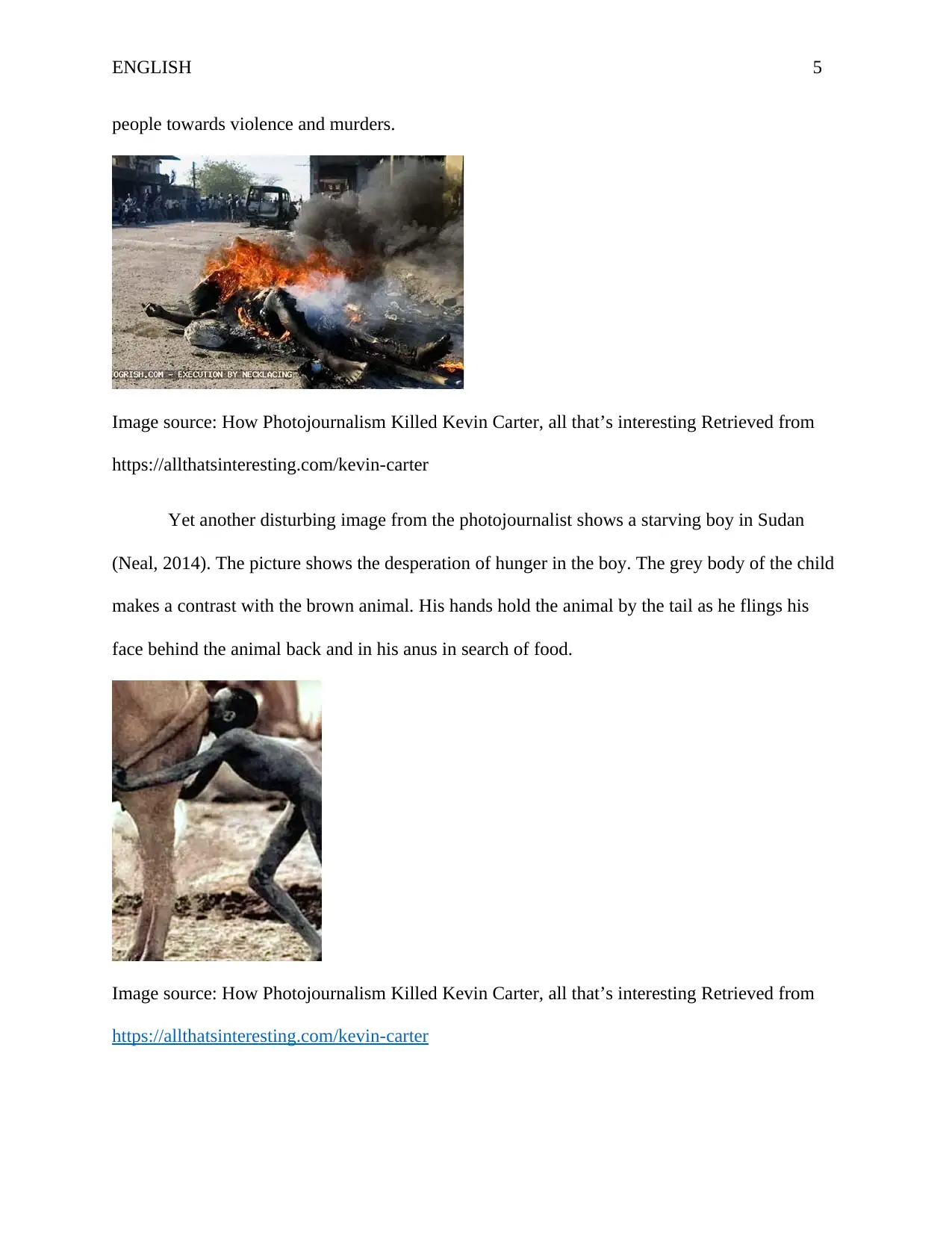
ENGLISH 5
people towards violence and murders.
Image source: How Photojournalism Killed Kevin Carter, all that’s interesting Retrieved from
https://allthatsinteresting.com/kevin-carter
Yet another disturbing image from the photojournalist shows a starving boy in Sudan
(Neal, 2014). The picture shows the desperation of hunger in the boy. The grey body of the child
makes a contrast with the brown animal. His hands hold the animal by the tail as he flings his
face behind the animal back and in his anus in search of food.
Image source: How Photojournalism Killed Kevin Carter, all that’s interesting Retrieved from
https://allthatsinteresting.com/kevin-carter
people towards violence and murders.
Image source: How Photojournalism Killed Kevin Carter, all that’s interesting Retrieved from
https://allthatsinteresting.com/kevin-carter
Yet another disturbing image from the photojournalist shows a starving boy in Sudan
(Neal, 2014). The picture shows the desperation of hunger in the boy. The grey body of the child
makes a contrast with the brown animal. His hands hold the animal by the tail as he flings his
face behind the animal back and in his anus in search of food.
Image source: How Photojournalism Killed Kevin Carter, all that’s interesting Retrieved from
https://allthatsinteresting.com/kevin-carter
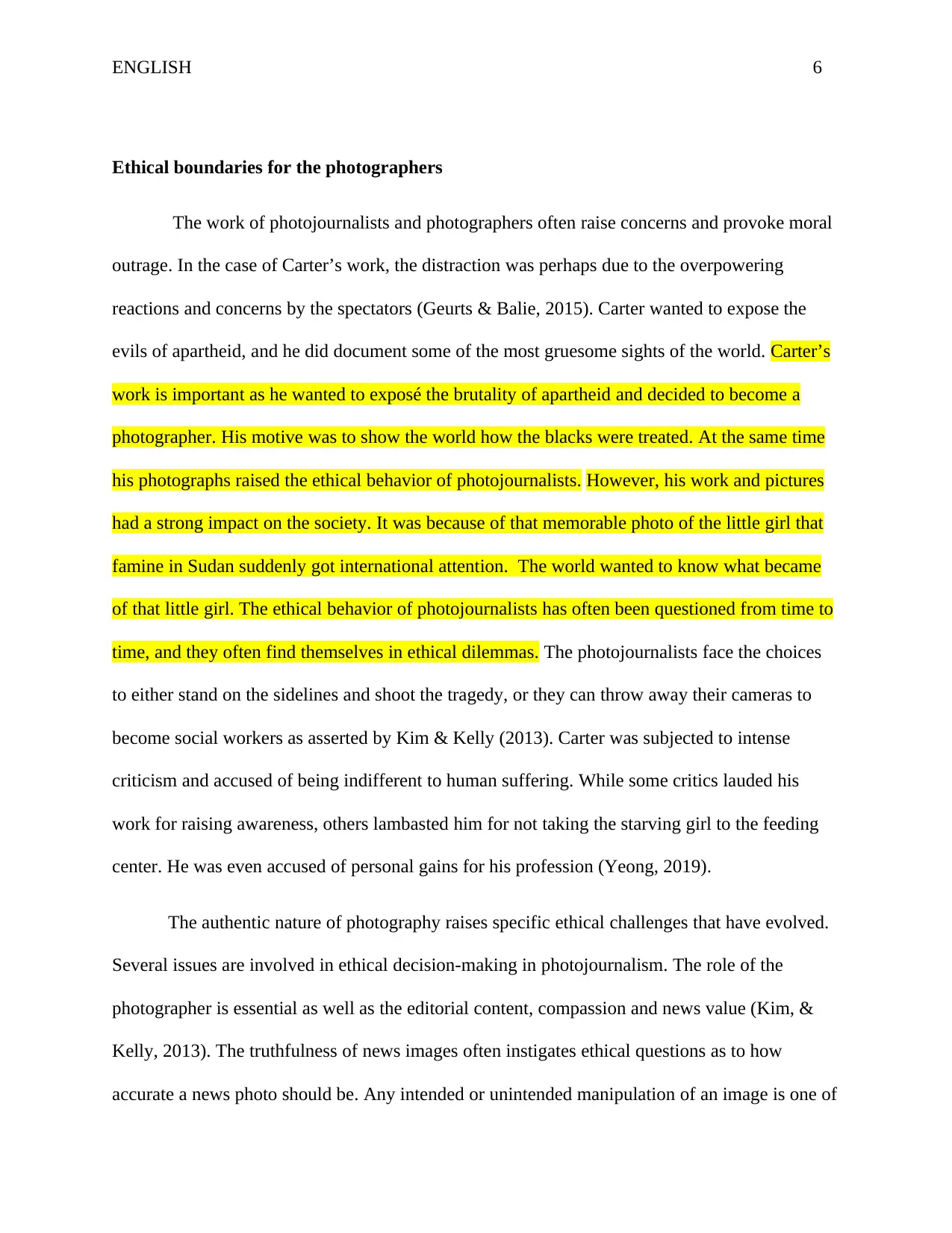
ENGLISH 6
Ethical boundaries for the photographers
The work of photojournalists and photographers often raise concerns and provoke moral
outrage. In the case of Carter’s work, the distraction was perhaps due to the overpowering
reactions and concerns by the spectators (Geurts & Balie, 2015). Carter wanted to expose the
evils of apartheid, and he did document some of the most gruesome sights of the world. Carter’s
work is important as he wanted to exposé the brutality of apartheid and decided to become a
photographer. His motive was to show the world how the blacks were treated. At the same time
his photographs raised the ethical behavior of photojournalists. However, his work and pictures
had a strong impact on the society. It was because of that memorable photo of the little girl that
famine in Sudan suddenly got international attention. The world wanted to know what became
of that little girl. The ethical behavior of photojournalists has often been questioned from time to
time, and they often find themselves in ethical dilemmas. The photojournalists face the choices
to either stand on the sidelines and shoot the tragedy, or they can throw away their cameras to
become social workers as asserted by Kim & Kelly (2013). Carter was subjected to intense
criticism and accused of being indifferent to human suffering. While some critics lauded his
work for raising awareness, others lambasted him for not taking the starving girl to the feeding
center. He was even accused of personal gains for his profession (Yeong, 2019).
The authentic nature of photography raises specific ethical challenges that have evolved.
Several issues are involved in ethical decision-making in photojournalism. The role of the
photographer is essential as well as the editorial content, compassion and news value (Kim, &
Kelly, 2013). The truthfulness of news images often instigates ethical questions as to how
accurate a news photo should be. Any intended or unintended manipulation of an image is one of
Ethical boundaries for the photographers
The work of photojournalists and photographers often raise concerns and provoke moral
outrage. In the case of Carter’s work, the distraction was perhaps due to the overpowering
reactions and concerns by the spectators (Geurts & Balie, 2015). Carter wanted to expose the
evils of apartheid, and he did document some of the most gruesome sights of the world. Carter’s
work is important as he wanted to exposé the brutality of apartheid and decided to become a
photographer. His motive was to show the world how the blacks were treated. At the same time
his photographs raised the ethical behavior of photojournalists. However, his work and pictures
had a strong impact on the society. It was because of that memorable photo of the little girl that
famine in Sudan suddenly got international attention. The world wanted to know what became
of that little girl. The ethical behavior of photojournalists has often been questioned from time to
time, and they often find themselves in ethical dilemmas. The photojournalists face the choices
to either stand on the sidelines and shoot the tragedy, or they can throw away their cameras to
become social workers as asserted by Kim & Kelly (2013). Carter was subjected to intense
criticism and accused of being indifferent to human suffering. While some critics lauded his
work for raising awareness, others lambasted him for not taking the starving girl to the feeding
center. He was even accused of personal gains for his profession (Yeong, 2019).
The authentic nature of photography raises specific ethical challenges that have evolved.
Several issues are involved in ethical decision-making in photojournalism. The role of the
photographer is essential as well as the editorial content, compassion and news value (Kim, &
Kelly, 2013). The truthfulness of news images often instigates ethical questions as to how
accurate a news photo should be. Any intended or unintended manipulation of an image is one of
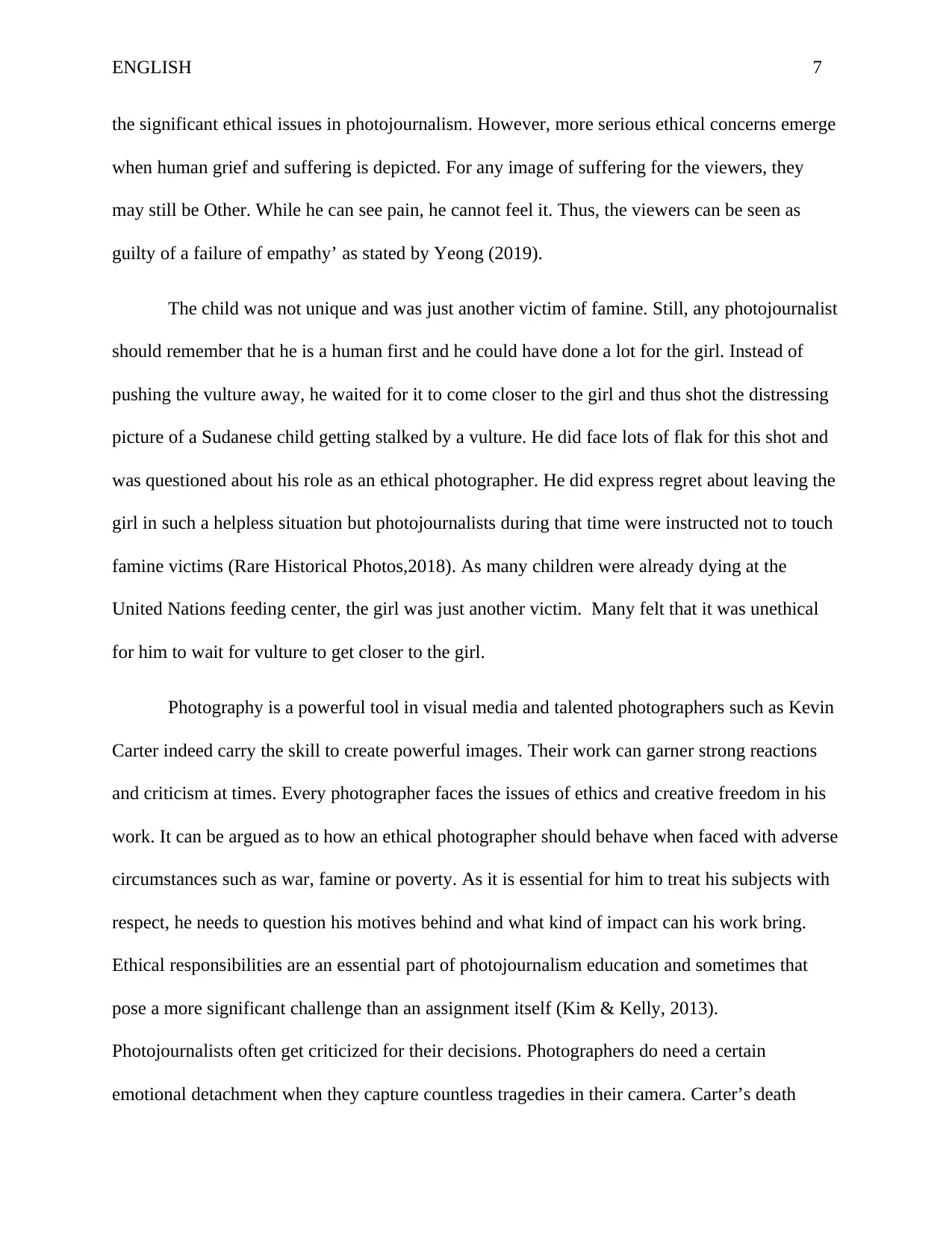
ENGLISH 7
the significant ethical issues in photojournalism. However, more serious ethical concerns emerge
when human grief and suffering is depicted. For any image of suffering for the viewers, they
may still be Other. While he can see pain, he cannot feel it. Thus, the viewers can be seen as
guilty of a failure of empathy’ as stated by Yeong (2019).
The child was not unique and was just another victim of famine. Still, any photojournalist
should remember that he is a human first and he could have done a lot for the girl. Instead of
pushing the vulture away, he waited for it to come closer to the girl and thus shot the distressing
picture of a Sudanese child getting stalked by a vulture. He did face lots of flak for this shot and
was questioned about his role as an ethical photographer. He did express regret about leaving the
girl in such a helpless situation but photojournalists during that time were instructed not to touch
famine victims (Rare Historical Photos,2018). As many children were already dying at the
United Nations feeding center, the girl was just another victim. Many felt that it was unethical
for him to wait for vulture to get closer to the girl.
Photography is a powerful tool in visual media and talented photographers such as Kevin
Carter indeed carry the skill to create powerful images. Their work can garner strong reactions
and criticism at times. Every photographer faces the issues of ethics and creative freedom in his
work. It can be argued as to how an ethical photographer should behave when faced with adverse
circumstances such as war, famine or poverty. As it is essential for him to treat his subjects with
respect, he needs to question his motives behind and what kind of impact can his work bring.
Ethical responsibilities are an essential part of photojournalism education and sometimes that
pose a more significant challenge than an assignment itself (Kim & Kelly, 2013).
Photojournalists often get criticized for their decisions. Photographers do need a certain
emotional detachment when they capture countless tragedies in their camera. Carter’s death
the significant ethical issues in photojournalism. However, more serious ethical concerns emerge
when human grief and suffering is depicted. For any image of suffering for the viewers, they
may still be Other. While he can see pain, he cannot feel it. Thus, the viewers can be seen as
guilty of a failure of empathy’ as stated by Yeong (2019).
The child was not unique and was just another victim of famine. Still, any photojournalist
should remember that he is a human first and he could have done a lot for the girl. Instead of
pushing the vulture away, he waited for it to come closer to the girl and thus shot the distressing
picture of a Sudanese child getting stalked by a vulture. He did face lots of flak for this shot and
was questioned about his role as an ethical photographer. He did express regret about leaving the
girl in such a helpless situation but photojournalists during that time were instructed not to touch
famine victims (Rare Historical Photos,2018). As many children were already dying at the
United Nations feeding center, the girl was just another victim. Many felt that it was unethical
for him to wait for vulture to get closer to the girl.
Photography is a powerful tool in visual media and talented photographers such as Kevin
Carter indeed carry the skill to create powerful images. Their work can garner strong reactions
and criticism at times. Every photographer faces the issues of ethics and creative freedom in his
work. It can be argued as to how an ethical photographer should behave when faced with adverse
circumstances such as war, famine or poverty. As it is essential for him to treat his subjects with
respect, he needs to question his motives behind and what kind of impact can his work bring.
Ethical responsibilities are an essential part of photojournalism education and sometimes that
pose a more significant challenge than an assignment itself (Kim & Kelly, 2013).
Photojournalists often get criticized for their decisions. Photographers do need a certain
emotional detachment when they capture countless tragedies in their camera. Carter’s death
Paraphrase This Document
Need a fresh take? Get an instant paraphrase of this document with our AI Paraphraser
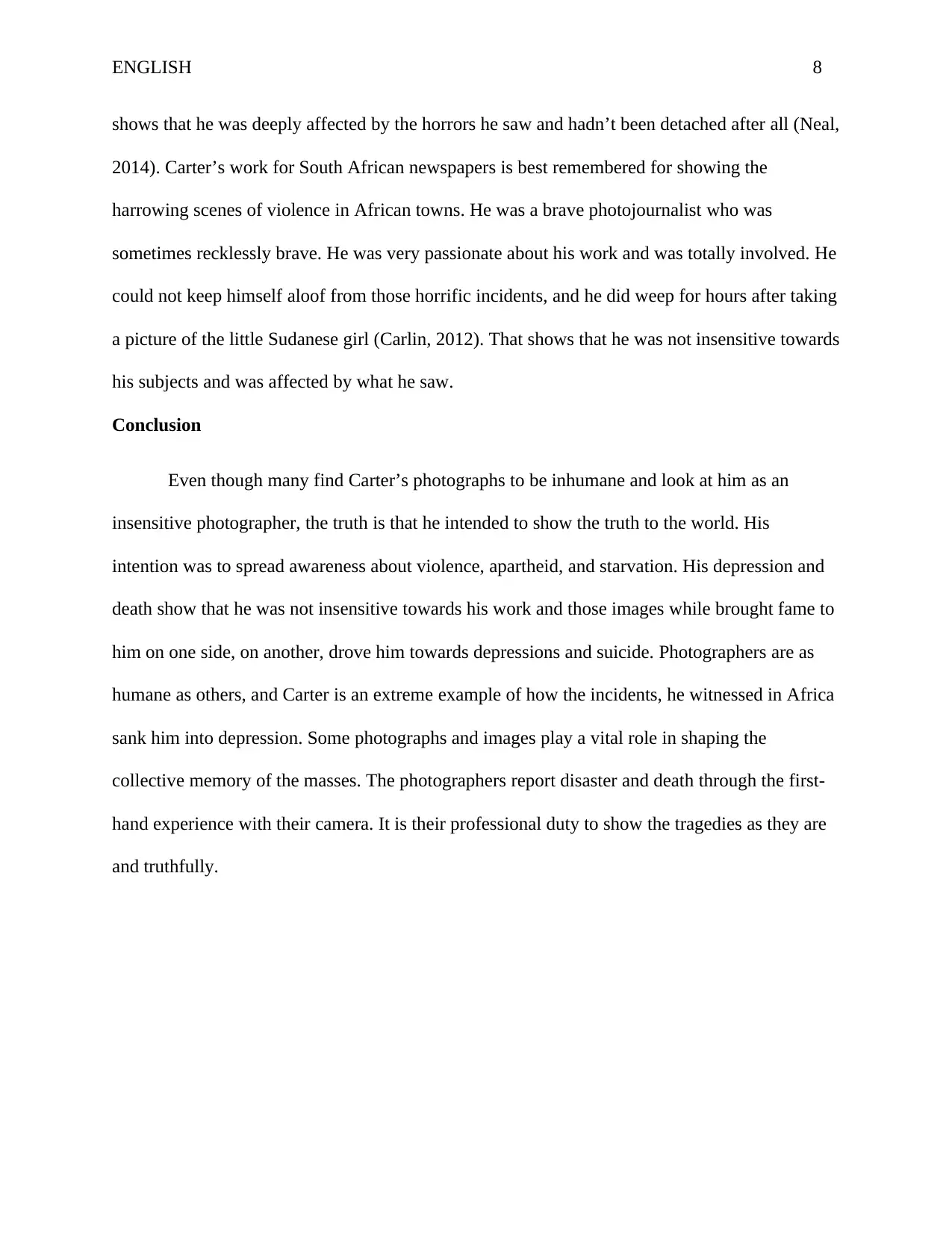
ENGLISH 8
shows that he was deeply affected by the horrors he saw and hadn’t been detached after all (Neal,
2014). Carter’s work for South African newspapers is best remembered for showing the
harrowing scenes of violence in African towns. He was a brave photojournalist who was
sometimes recklessly brave. He was very passionate about his work and was totally involved. He
could not keep himself aloof from those horrific incidents, and he did weep for hours after taking
a picture of the little Sudanese girl (Carlin, 2012). That shows that he was not insensitive towards
his subjects and was affected by what he saw.
Conclusion
Even though many find Carter’s photographs to be inhumane and look at him as an
insensitive photographer, the truth is that he intended to show the truth to the world. His
intention was to spread awareness about violence, apartheid, and starvation. His depression and
death show that he was not insensitive towards his work and those images while brought fame to
him on one side, on another, drove him towards depressions and suicide. Photographers are as
humane as others, and Carter is an extreme example of how the incidents, he witnessed in Africa
sank him into depression. Some photographs and images play a vital role in shaping the
collective memory of the masses. The photographers report disaster and death through the first-
hand experience with their camera. It is their professional duty to show the tragedies as they are
and truthfully.
shows that he was deeply affected by the horrors he saw and hadn’t been detached after all (Neal,
2014). Carter’s work for South African newspapers is best remembered for showing the
harrowing scenes of violence in African towns. He was a brave photojournalist who was
sometimes recklessly brave. He was very passionate about his work and was totally involved. He
could not keep himself aloof from those horrific incidents, and he did weep for hours after taking
a picture of the little Sudanese girl (Carlin, 2012). That shows that he was not insensitive towards
his subjects and was affected by what he saw.
Conclusion
Even though many find Carter’s photographs to be inhumane and look at him as an
insensitive photographer, the truth is that he intended to show the truth to the world. His
intention was to spread awareness about violence, apartheid, and starvation. His depression and
death show that he was not insensitive towards his work and those images while brought fame to
him on one side, on another, drove him towards depressions and suicide. Photographers are as
humane as others, and Carter is an extreme example of how the incidents, he witnessed in Africa
sank him into depression. Some photographs and images play a vital role in shaping the
collective memory of the masses. The photographers report disaster and death through the first-
hand experience with their camera. It is their professional duty to show the tragedies as they are
and truthfully.
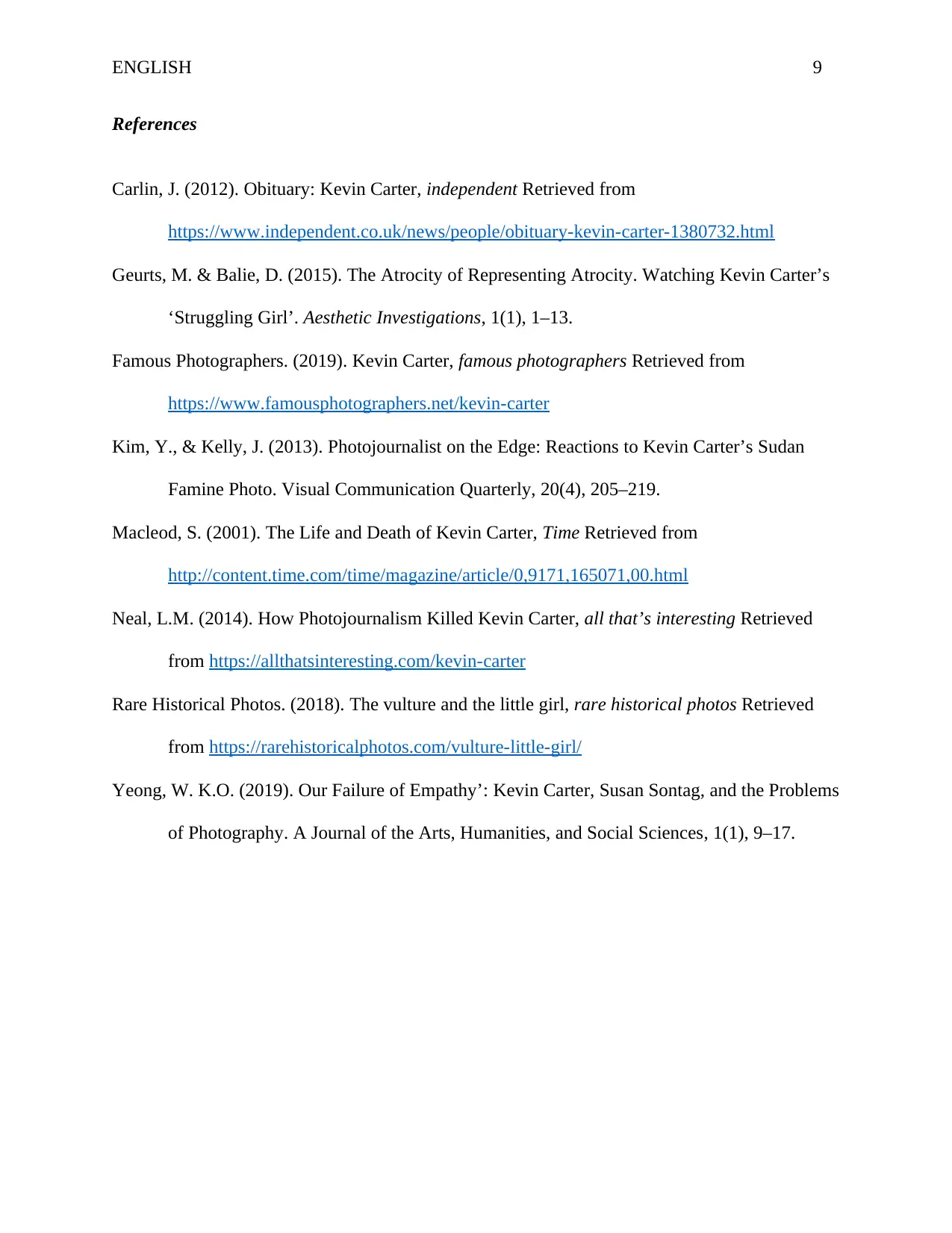
ENGLISH 9
References
Carlin, J. (2012). Obituary: Kevin Carter, independent Retrieved from
https://www.independent.co.uk/news/people/obituary-kevin-carter-1380732.html
Geurts, M. & Balie, D. (2015). The Atrocity of Representing Atrocity. Watching Kevin Carter’s
‘Struggling Girl’. Aesthetic Investigations, 1(1), 1–13.
Famous Photographers. (2019). Kevin Carter, famous photographers Retrieved from
https://www.famousphotographers.net/kevin-carter
Kim, Y., & Kelly, J. (2013). Photojournalist on the Edge: Reactions to Kevin Carter’s Sudan
Famine Photo. Visual Communication Quarterly, 20(4), 205–219.
Macleod, S. (2001). The Life and Death of Kevin Carter, Time Retrieved from
http://content.time.com/time/magazine/article/0,9171,165071,00.html
Neal, L.M. (2014). How Photojournalism Killed Kevin Carter, all that’s interesting Retrieved
from https://allthatsinteresting.com/kevin-carter
Rare Historical Photos. (2018). The vulture and the little girl, rare historical photos Retrieved
from https://rarehistoricalphotos.com/vulture-little-girl/
Yeong, W. K.O. (2019). Our Failure of Empathy’: Kevin Carter, Susan Sontag, and the Problems
of Photography. A Journal of the Arts, Humanities, and Social Sciences, 1(1), 9–17.
References
Carlin, J. (2012). Obituary: Kevin Carter, independent Retrieved from
https://www.independent.co.uk/news/people/obituary-kevin-carter-1380732.html
Geurts, M. & Balie, D. (2015). The Atrocity of Representing Atrocity. Watching Kevin Carter’s
‘Struggling Girl’. Aesthetic Investigations, 1(1), 1–13.
Famous Photographers. (2019). Kevin Carter, famous photographers Retrieved from
https://www.famousphotographers.net/kevin-carter
Kim, Y., & Kelly, J. (2013). Photojournalist on the Edge: Reactions to Kevin Carter’s Sudan
Famine Photo. Visual Communication Quarterly, 20(4), 205–219.
Macleod, S. (2001). The Life and Death of Kevin Carter, Time Retrieved from
http://content.time.com/time/magazine/article/0,9171,165071,00.html
Neal, L.M. (2014). How Photojournalism Killed Kevin Carter, all that’s interesting Retrieved
from https://allthatsinteresting.com/kevin-carter
Rare Historical Photos. (2018). The vulture and the little girl, rare historical photos Retrieved
from https://rarehistoricalphotos.com/vulture-little-girl/
Yeong, W. K.O. (2019). Our Failure of Empathy’: Kevin Carter, Susan Sontag, and the Problems
of Photography. A Journal of the Arts, Humanities, and Social Sciences, 1(1), 9–17.
1 out of 9
Your All-in-One AI-Powered Toolkit for Academic Success.
+13062052269
info@desklib.com
Available 24*7 on WhatsApp / Email
![[object Object]](/_next/static/media/star-bottom.7253800d.svg)
Unlock your academic potential
© 2024 | Zucol Services PVT LTD | All rights reserved.